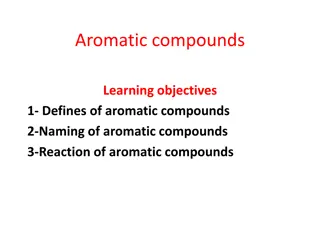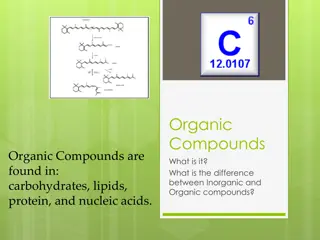Understanding Polycyclic Aromatic Hydrocarbons (PAHs) and Their Impact
Polycyclic Aromatic Hydrocarbons (PAHs) are ubiquitous environmental pollutants found in nature and from human activities like combustion. They affect public water construction permitting processes by influencing material standards. PAHs can be harmful concerning health when soils are disturbed during construction, requiring proper management plans for safe handling.
Download Presentation

Please find below an Image/Link to download the presentation.
The content on the website is provided AS IS for your information and personal use only. It may not be sold, licensed, or shared on other websites without obtaining consent from the author. Download presentation by click this link. If you encounter any issues during the download, it is possible that the publisher has removed the file from their server.
E N D
Presentation Transcript
POLYCYCLIC AROMATIC HYDROCARBONS Polycyclic Aromatic Hydrocarbons (PAHs) Polycyclic Aromatic Hydrocarbons (PAHs) What are they? What are they? Where are they? Where are they? How do their presence change the public water construction permitting How do their presence change the public water construction permitting process? process? Other considerations Other considerations
WHAT ARE PAHS? PAHs [Polycyclic Aromatic Hydrocarbons] are ubiquitous environmental pollutants. They are not only found naturally in the environment but they can also be man made. PAHs are formed as a result of incomplete combustion of carbon-containing materials, such as wood, coal, oil, gas, or biomass. They are also created in car and diesel exhaust, smoked or charbroiled food, and are present in cigarette smoke condensate, and tobacco products. M. Huang, T.M. Penning, in Encyclopedia of Food Safety, 2014 A PAH that many of us have heard of is Naphthalene. Naphthalene is a man made PAH used to make mothballs, etc.
WHERE ARE PAHS Identified releases of hazardous materials to the environment, regulated by Waste Management and Prevention Division. Urban soils, aka, Development Soils. See the Urban Soil Background Area layer on the ANR Atlas. More information about this can be found on the Waste Management and Prevention Division s website at https://dec.vermont.gov/waste- management/contaminated-sites/guidance. A fact sheet on locating the area of a town where these criteria may apply, and providing a brief description of the mitigation targets: https://dec.vermont.gov/sites/dec/files/wmp/Sites/2019.1 0.29.development.soils_.factsheet.pdf Screen shot from ANR Atlas 6/13/22. Blue shading = Urban Soil Background Areas. Red circles to draw attention to some of the largest, identified areas in VT. The Vermont evaluation of background soils is located at: https://dec.vermont.gov/sites/dec/files/wmp/Sites/4.1 1.17.TextOnly.Vermont.Soil_.Report.FINAL_.pdf
DO PAHS AFFECT PUBLIC WATER CONSTRUCTION PERMITTING Currently, there are no changes proposed to our public water construction permits. However, Appendix A, Subpart 8.0.1 of the Vermont Water Supply Rule states: Pipe, fittings, valves and fire hydrants shall conform to the latest standards issued by the AWWA. ANSI/AWWA Standards C900 through C950; if a water main must pass through an area of gross contamination, the manufacturer must be consulted regarding the permeation of pipe walls and joint fittings prior to selecting the material. The contaminant matters - Napthalene (PVC not resistant to this), Anthraquinone (PVC generally resistant to this)
OTHER CONSIDERATIONS The health concern with PAHs soils disturbed during construction projects is primarily from direct contact. The Consultant or subconsultant needs to put together a soil management plan. This plan needs to be reviewed and approved by the Waste Management and Prevention Division. The soil management plan will involve steps to identify and quantify the conditions, to inform work measures, and disposal documentation. Project development must allow the necessary timeframe for identification of conditions, prior to excavation, that can be interrupted by unplanned discovery of condition requiring regulatory oversight. This work should be considered during the Preliminary Engineering phase of the project.
YOUR EXPERIENCES Wayne Elliott, PE, President of Aldrich + Elliott, PC























